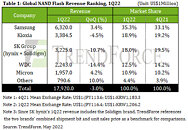
Micron Ships World's Most Advanced DRAM Technology With 1-Beta Node
Micron Technology, Inc., announced today that it is shipping qualification samples of its 1β (1-beta) DRAM technology to select smartphone manufacturers and chipset partners and has achieved mass production readiness with the world's most advanced DRAM technology node. The company is debuting its next generation of process technology on its low-power double data rate 5X (LPDDR5X) mobile memory, delivering top speed grades of 8.5 gigabits (Gb) per second. The node delivers significant gains across performance, bit density and power efficiency that will have sweeping market benefits. Beyond mobile, 1β delivers the low-latency, low-power, high-performance DRAM that is essential to support highly responsive applications, real-time services, personalization and contextualization of experiences, from intelligent vehicles to data centers.
The world's most advanced DRAM process node, 1β represents an advancement of the company's market leadership cemented with the volume shipment of 1α (1-alpha) in 2021. The node delivers around a 15% power efficiency improvement and more than a 35% bit density improvement with a 16Gb per die capacity. "The launch of our 1-beta DRAM signals yet another leap forward for memory innovation, brought to life by our proprietary multi-patterning lithography in combination with leading-edge process technology and advanced materials capabilities," said Scott DeBoer, executive vice president of technology and products at Micron. "In delivering the world's most advanced DRAM technology with more bits per memory wafer than ever before, this node lays the foundation to usher in a new generation of data-rich, intelligent and energy-efficient technologies from the edge to the cloud."
The world's most advanced DRAM process node, 1β represents an advancement of the company's market leadership cemented with the volume shipment of 1α (1-alpha) in 2021. The node delivers around a 15% power efficiency improvement and more than a 35% bit density improvement with a 16Gb per die capacity. "The launch of our 1-beta DRAM signals yet another leap forward for memory innovation, brought to life by our proprietary multi-patterning lithography in combination with leading-edge process technology and advanced materials capabilities," said Scott DeBoer, executive vice president of technology and products at Micron. "In delivering the world's most advanced DRAM technology with more bits per memory wafer than ever before, this node lays the foundation to usher in a new generation of data-rich, intelligent and energy-efficient technologies from the edge to the cloud."




































